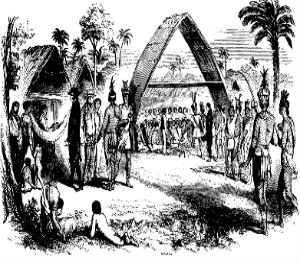Like the aborigines of Australia, the Lucayan Indians were the first people of what is now called the Bahamas. The tribe is related to the Taino Indians, who had many living descendants. However, unlike the aborigines, the Lucayan people no longer exist.
Between 700 and 1500, Lucayan culture flourished. Archaeological findings have determined that their homes were simple pole-and-thatch, but designed to house several families apiece, suggesting that their society was matriarchal and political. Tools made of stone and bone, stone ceremonial chairs, pottery made from clay and shells, are the main artifacts that remain. Like many island cultures, the Lucayan people fished, grew crops and had a trading network with other islands. The Lucayans grew cotton for trade and for making simple necessities. They grew agave for food, but ate mostly shellfish. Though not known to be tobacco users, they sensed the value of it and grew the leaves for trade with others.
Christopher Columbus first touched land here, searching for gold, and the first people he encountered in 1492 were Lucayans. His observations are the first surviving description of them in their original habitat. They were astonishingly attractive people, tall and slender, with straight, black hair kept short but for a few strands in back. Women practiced "head flattening," shaping and lengthening an infant's skull by binding it during the first few months of life. In general, they went mostly naked and were seen to be a peace-loving people. They had no indigenous enemies, except for the occasional Carib Indian war party.
Columbus "exported" a small number of Lucayans to Spain when he returned to his country. What happened to them is not known. What is known, is that his voyage was the first of a building invasion of the New World by the Spanish. Because there was no gold to be found in the islands, many voyagers simply continued to the west, where they found other natives, and riches beyond their dreams.
Still, others stayed on these fair islands. Within a few years, the Bahamas were being exploited for slave labor, that being the only valuable resource available in the eyes of the grasping Europeans. From a peak population of about 40,000 at Columbus' arrival, the Lucayans underwent a rapid decline. They were enslaved, forced to marry out of their culture, and ravaged by disease. By 1520, the Lucayans had ceased to exist as a separate race and society.
As the Bahamas were emptied of their original inhabitants, the Spanish turned to Florida to find new sources of slaves. Eventually, the Taino were supplanted by Africans in the slave markets of the world.
The Lucayan tribe was a branch of the Taino people. Through enslavement, they were scattered throughout Europe. There are many people of mixed Taino, African and Cuban descent living today, a rich diversity that adds to the vibrancy of today's Bahamas. Sadly, there will never be another Lucayan.

